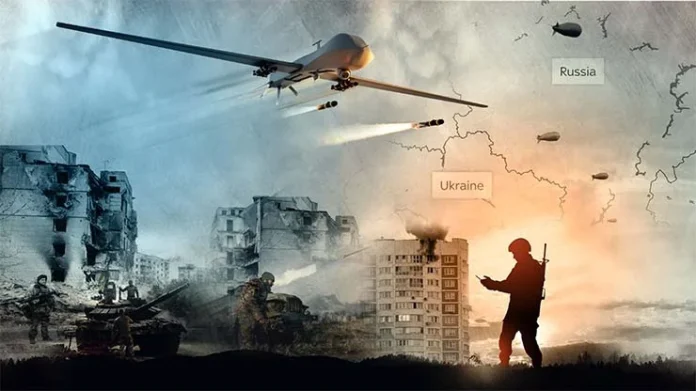On November 25, 2023, Russia launched its largest drone attack since the start of the Ukraine War, damaging several facilities, including critical infrastructure and civilian and commercial buildings throughout the country. Massed drone attacks, which are now increasingly common in the ongoing war in Europe, have played a key role in the decimation of the Ukrainian Army, which has lost up to 400,000 soldiers, almost its entire air force and the vast majority of its artillery and armour in the 20 months of this conflict.
Two of the most potent weapons in Russia’s arsenal are the Lancet and the Iranian Shahed-136. Moscow has extensively deployed its Lancet drones alongside the Shahed-136 to carry out ground-based kamikaze strikes on high-value targets inside Ukraine. Russian tactics have been simple but highly effective; it first sends the Shahed near high-value Ukrainian military targets (such as surface-to-air missile batteries or tanks columns) as bait to gauge their exact location. Once the location of the enemy concentration is established, the Lancet loitering munitions are sent to obliterate the target. The Lancet was solely responsible for the destruction of 45 percent of NATO artillery.
According to the Russian Defence Ministry, since the start of the war, Ukraine has lost 491 aircraft, 251 helicopters, 8,004 unmanned aerial vehicles, 441 surface-to-air missile systems, 12,746 tanks and other armoured combat vehicles, 1,163 multiple rocket launchers, 6,810 field artillery guns and mortars and 14,419 special military motor vehicles.
Though outgunned and outskilled, the Ukrainians have used their own drones to strike back at Russia, with naval bases, airfields and fuel depots among the recent targets. Russia has seen a sharp rise in unmanned aerial vehicles carrying out assaults on western, central and southern Russian regions as well as the capital Moscow and Crimea.
Massed drone attacks, which are now increasingly common in the ongoing war in Europe, have played a key role in the decimation of the Ukrainian Army, which has lost up to 400,000 soldiers, almost its entire air force and the vast majority of its artillery and armour in the 20 months of this conflict
The ongoing conflict in Ukraine has brought to light the transformative impact of drone technology on modern warfare. Russia’s use of kamikaze drones, specifically designed for destructive missions, has altered the dynamics of the battlefield, enabling them to target armoured vehicles and soldiers effectively. This development raises significant considerations for countries like India, prompting a reassessment of military strategies and the integration of drone technology at the tactical level.
The Role of Kamikaze Drones in Ukraine
The Ukraine War has witnessed a notable increase in the use of kamikaze drones by Russian forces. These unmanned aerial vehicles (UAVs) are designed to carry explosives and crash into their targets, causing significant damage. The ability of these drones to target armoured vehicles and personnel has proven to be a game-changer, providing a cost-effective means of neutralising enemy assets.
One of the key advantages of kamikaze drones is their agility and versatility. They can navigate complex terrains, evade traditional defences, and strike with precision. This has allowed Russian forces to swiftly eliminate threats on the battlefield, contributing to a shorter duration of conflict.

Lessons for India
India, as a nation with a complex security landscape, can draw valuable lessons from the Ukraine War and the use of kamikaze drones. The following considerations highlight the potential benefits and implications for India’s defence strategy:
- Intelligence Gathering: Drones play a crucial role in intelligence, surveillance, and reconnaissance (ISR) operations. Integrating drones into India’s military operations can enhance real-time intelligence gathering, providing valuable information on enemy movements, positions, and intentions. This, in turn, empowers Indian forces to make informed decisions and respond effectively to emerging threats.
- Pre-emptive Strikes: The use of drones for pre-emptive strikes can disrupt enemy plans and capabilities. India can deploy drones to target high-value assets, such as enemy military installations or equipment, before they pose a direct threat. This proactive approach can be instrumental in gaining a strategic advantage and reducing the risk to Indian forces.
One of the key advantages of kamikaze drones is their agility and versatility. They can navigate complex terrains, evade traditional defences, and strike with precision. This has allowed Russian forces to swiftly eliminate threats on the battlefield, contributing to a shorter duration of conflict
- Cost-Effective Warfare: Kamikaze drones have demonstrated their cost-effectiveness in warfare. Compared to traditional military assets, drones offer a more economical option for achieving military objectives. India can explore the development and deployment of affordable drone technology to optimize defence spending while maintaining operational effectiveness.
- Adaptability and Flexibility: The adaptability and flexibility of drone technology make it suitable for diverse operational scenarios. Whether in conventional conflicts or counter-insurgency operations, drones can be customized to meet specific mission requirements. India can leverage this flexibility to address its unique security challenges effectively.
The Israel-Hamas Conflict and the Threat of Drone Attacks
The Israel-Hamas conflict further highlights the evolving nature of warfare, with reports of Iranians attacking the US aircraft carriers and commercial vessels using drones. In December 2023, a Liberia-flagged, Japanese-owned and Netherlands-operated chemical tanker was struck, causing structural damage. The incident took place 370 km southwest of the city of Veraval, Gujarat. The incident underscores the need for nations to enhance their defences against drone threats in both military and civilian contexts.
Conclusion
As the nature of warfare continues to evolve, the lessons learned from conflicts like the Ukraine War and the Israel-Hamas conflict emphasise the critical role of drone technology in modern military strategies. India has the opportunity to leverage the advantages offered by drones, not only for defence but also for enhancing its overall security posture. The integration of drones at the tactical level can empower Indian forces with improved intelligence, pre-emptive strike capabilities, and cost-effective solutions to address emerging threats on multiple fronts.
– The writer is a globally cited defence analyst. His work has been published by leading think tanks, and quoted extensively in books on diplomacy, counter terrorism, warfare and economic development. The views expressed are of the writer and do not necessarily reflect the views of Raksha Anirveda
–The writer is a globally cited defence analyst based in New Zealand. The views expressed are of the writer and do not necessarily reflect the views of Raksha Anirveda






